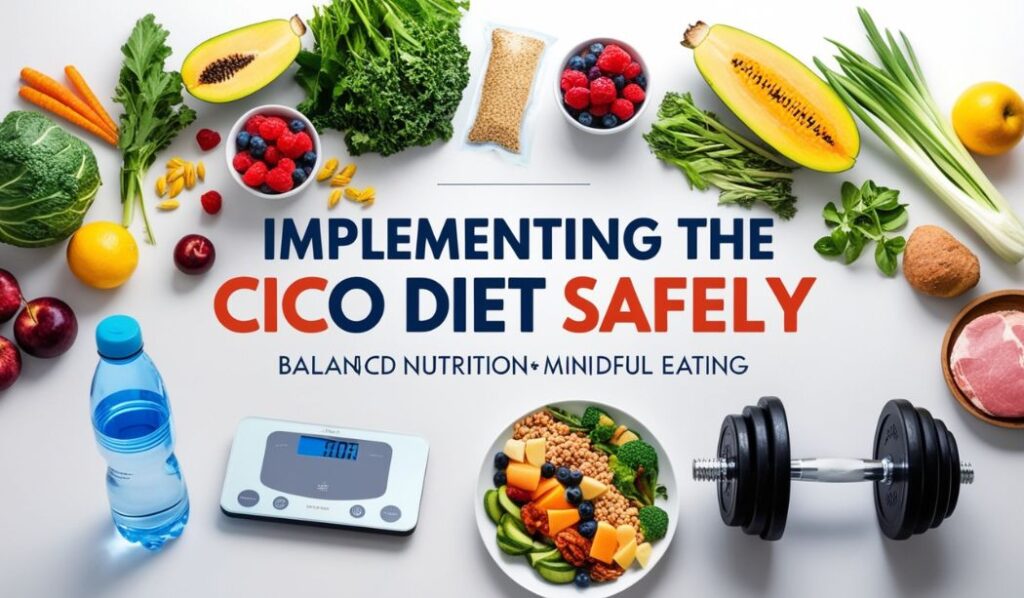The journey to losing weight is full of theories and conflicting advice, each new fad claiming to unlock effective results easily.
Among these, calorie counting, or CICO, has gained significant mindshare. But what exactly does following CICO entail, and what does it require of those looking to adopt its principles?
At its core, the CICO approach is predicated on straightforward logic: consume fewer calories than you expend daily to facilitate weight loss to facilitate weight loss.
Yet, fully appreciating the nuances of monitoring caloric intake, estimating energy output, and optimizing nourishment demands careful consideration.
What is the CICO Diet?
The Calories In Calories Out methodology has anchored weight management strategies for generations.
Its premise is irrefutable – an imbalance between energy intake and expenditure will upset stability on the scale.
Consume more than the body burns and inevitably gains; burn more than enters, and loss ensues. This caloric accounting remains the linchpin of dropping pounds for those seeking a trimmer silhouette.
The CICO approach eschews prescribed provisions or planned provisions. Instead, it focuses on the quantitative calories coming and going.
This conceptualizes theoretically eating anything as long as a deficit develops—ingesting fewer calories than needed to maintain the current mass. Some sustenance satisfies more than others in equal portions, so choices require circumspection to stay under daily limits and in energy-negative territory.
The Science Behind Calorie Counting and Weight Loss
- Basal Metabolic Rate (BMR): The number of calories your body needs at rest to maintain vital functions like breathing and circulation.
- Thermic Effect of Food (TEF): The energy required to digest, absorb, and metabolize the food you consume.
- Physical Activity Level (PAL): The calories burned through physical activities, including exercise and non-exercise activities like walking or standing.
- Non-Exercise Activity Thermogenesis (NEAT): The energy expended for everything we do that is not sleeping, eating, or sports-like exercise.
To lose weight productively with the CICO eating routine, you need to create a vitality shortage by expelling fewer calories than your TDEE.
In this case, to lose one pound of body weight, you have to make a shortage of around 3,500 calories.
How to Calculate Your Calorie Needs
Understanding how many calories you need daily is critical to developing a personalized weight loss strategy tailored precisely for you.
Basal Metabolic Rate (BMR): Your BMR can be estimated using various formulas that take into account characteristics such as your age, sex, weight, and height, such as the frequently used Mifflin-St Jeor or Harris-Benedict equations.
Activity Factor: Your activity factor depends on your physical activity levels each week. It can range from sedentary with minimal or no exercise to highly active with intense workouts multiple times per week.
Numerous online calorie calculators can aid in determining your TDEE by requesting essential particulars about your body and lifestyle habits. Once you learn your TDEE, you can decide how many calories to consume daily to produce the desired calorie deficit for weight reduction.
Benefits of the CICO Diet
- Flexibility in Food Choices: Unlike restrictive diets that prohibit specific foods, the CICO approach allows freedom with what you eat. As long as daily calories remain under the limit, any food is possible, even beloved splurges.
- Simplicity: The plan necessitates understanding a single concept—burn more than you consume. No recipes, guidelines, or food groups require memorizing. Maintain calorie awareness alone.
- Encourages Awareness of Food Intake: Counting intake boosts insight into typical serving sizes and calorie densities. This consciousness transfers to occasional choices, helping moderate overindulgence.
- Promotes Weight Loss: When applied correctly, CICO efficiently motivates weight reduction. Forcing the body to utilize stored fat for energy through a calorie shortfall creates loss over the long haul.
Potential Drawbacks and Criticisms
Nutrient Deficiencies
Emphasis solely on calorie consumption could neglect the quality of nutrients attained. A low-calorie eating plan that lacks vital nutrients is feasible, potentially causing health issues over the long term.
Doesn’t Address Food Quality
The CICO diet fails to differentiate where calories originate. Therefore, 100 calories from sweets are viewed as equivalent to 100 calories from vegetables rich in nutrients, in spite of their greatly differing impacts on health and fullness sensations.
Sustainability Issues
For some individuals, meticulously counting calories regularly could become tedious and unsustainable in the long term. It may also bring about unhealthy fixations with food and monitoring calories consumed.
Impact on Metabolic Rate
Prolonged calorie reduction can lower the basal metabolic rate, implying the body becomes more proficient in utilizing fewer calories, risking slower weight loss and hitting a plateau.
Psychological Impact
Constant focus on calorie counting may heighten stress levels or contribute to a negative relationship with eating, risking eating disorders or binge consuming.
Implementing the CICO Diet Safely
Focus on Nutrient-Dense Foods
While the CICO diet permits flexibility, it is pivotal to prioritize nutrient-dense foods like fruits, greens, entire grains, lean proteins, and healthful fats. These foods furnish crucial nutrients, keep you full for extended periods, and boost your overall condition.
Monitor Portion Sizes
Maintain watchfulness over portion dimensions to prevent consuming more calories than intended. Smaller dishes, measuring cups, or digital scales can help precisely track your food consumption.
Stay Hydrated
Drinking plenty of water throughout the day can help control appetite and support overall wellness. Sometimes, thirst can be mistaken for hunger, leading to unnecessary calorie intake.
Include Physical Activity
Combining calorie decrement with increased physical activity can enhance weight loss and improve cardiovascular health, muscle tone, and general well-being.
Avoid Extreme Calorie Deficits
Extremely low-calorie diets can lead to muscle loss, nutrient deficiencies, and metabolic slowing. Aim for a moderate shortfall that fosters steady, sustainable weight reduction—typically 500 to 1,000 calories daily.
Listen to Your Body
Pay attention to hunger cues and avoid restrictive or overly punitive eating patterns. Ensure you consume enough calories to meet your body’s primary energy needs.
The Role of a Dietitian in a CICO Diet
While embarking on a weight loss journey, working closely with a registered dietitian can be immensely valuable.
The dietitian can craft a customized Calorie-in, Calorie-out diet plan tailored to one’s specific needs, objectives, and preferences while ensuring nutritional requirements are satisfied.
They offer guidance on proper portion sizes for various foods and strategies for managing cravings and preventing overindulgence.
Moreover, dietitians can help address potential issues related to the Calorie In, Calorie Out approach, such as deficiencies in micronutrients or dysfunctional eating relationships, and lend support for individuals with certain health conditions, such as type 2 diabetes, cardiovascular disease, or sleep apnea.
Common Misconceptions About the CICO Diet
- “All calories are equal.” While focusing on caloric balance, calories sourced from nutrient-dense whole foods supply essential vitamins, minerals, and satiety to fuel the body properly. In contrast, calorie-bombs from junk lack nutrition and leave one hungry soon after.
- “You can eat whatever you want.” Technically, this is true, but a diet relying solely on calorie counting risks poor dietary choices that are detrimental to overall wellness in the long term. Balance is paramount for sustaining success.
- “It’s just about calories.” While maintaining a caloric deficit is vital to weight loss, other factors like metabolism, hormones, rest, and stress shape how the body reacts to fewer calories. Taking a holistic view is essential.
Popular Alternatives to the CICO Diet
- Keto Diet: The ketogenic regimen prioritizes fats and restricts carbs, compelling the body to utilize stored fat instead of glucose. While effective short-term for some, maintaining this drastic long-term shift without periodic flexibility could be challenging.
- Intermittent Fasting Involves cycling between periods of nourishment and periods of nutritional neglect. Beyond weight management, proponents assert this practice may offer supplemental perks like optimized blood markers.
- Noom: The digital Noom platform couples calorie accounting with behavioral science to inspire weight loss, lifestyle upgrades, and healthier habits.
- Plant-Based Diets: Diets focused on plant-based whole foods like fruits, vegetables, beans, and grains tend to be low in calories yet rich in nutrients, supporting both scale reductions and overall wellness.
- Low-Calorie Diets: Calorie-controlled regimens, which are mindful of portion sizes and nutritious selections, can shed pounds through meals that maximize nutritional value for minimal energy intake.
Incorporating Mindfulness and Behavioral Changes
Mindful Eating: Consciously savoring every morsel can help curb overconsumption and optimize meal gratification. Making a concerted effort to acknowledge physical fullness signals promotes more intuitive dining.
Tracking Progress: Consistently logging nourishment intake using paper records or smartphone apps can illuminate dietary patterns and triggers contributing to overindulgence. Tracking changes over time empowers continued adjustments.
Setting Realistic Goals: Adopting achievable, step-by-step goals like gradually shedding one to two pounds weekly forestalls burnout and preserves determination. Unrealistic targets set the stage for disappointment.
Building Healthy Habits: Prioritizing the cultivation of sustainable habits, including routine physical activity, sufficient rest, and measures to reduce stress, may prove more dependable in the long term than relying exclusively on calorie counting for weight regulation.
My Opinion
The CICO diet offers a straightforward method for weight loss centered around balancing energy intake and expenditure through monitoring calories.
While simple to follow and allowing for varied food choices, carefully considering nutrition is critical for success. Mindfully reducing consumption while maintaining focus on overall wellness helps maximize benefits.
Understanding the science behind tracking intake aids in determining individual needs accurately.
Incorporating healthy habits alongside nutrient-dense options facilitates making CICO work as intended.
Limiting calories alone and making informed decisions that promote sustaining health over time can yield lasting results. Consultation with a dietitian can personalize guidance tailored to the unique objectives and needs of those exploring this approach.





















Leave a Reply
View Comments